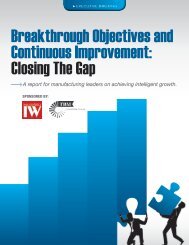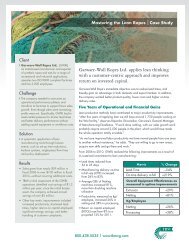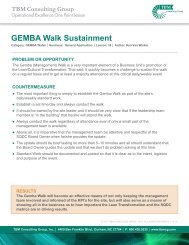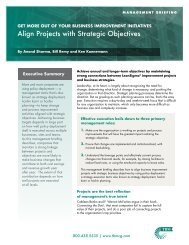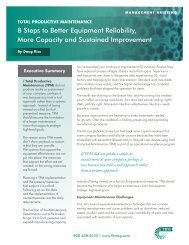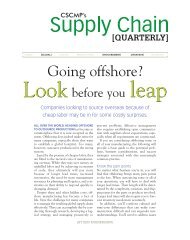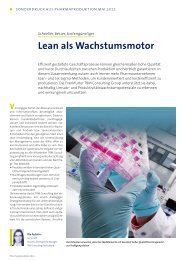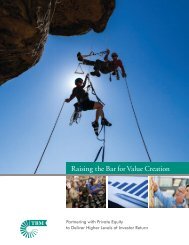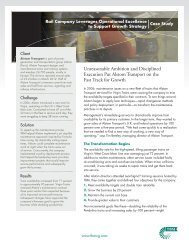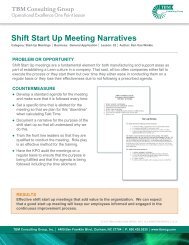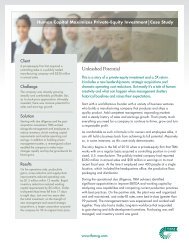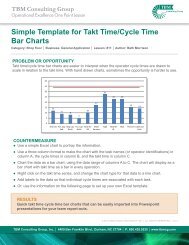clicking here - TBM Consulting Group
clicking here - TBM Consulting Group
clicking here - TBM Consulting Group
Create successful ePaper yourself
Turn your PDF publications into a flip-book with our unique Google optimized e-Paper software.
P G . 3<br />
The Three Stages of a Lasting<br />
Business Transformation, and<br />
How To Keep Moving Forward<br />
The Tool-Driven Stage<br />
1 TOOL DRIVEN 2 SYSTEM DRIVEN 3 PRINCIPLE DRIVEN<br />
Although the process improvements are obvious if<br />
you walk through the factory—they include dramatic<br />
inventory reductions and productivity improvements,<br />
and cleanliness if 5S is emphasized—these efforts<br />
may not have made a significant impact on the P&L<br />
statements, at least not yet. Costs have certainly been<br />
reduced, margins have been improved, and inventory<br />
reductions have reduced working capital requirements.<br />
But major financial benefits haven’t been fully captured<br />
because the emphasis is still on operational issues.<br />
To move to the system-driven stage, business<br />
leaders should:<br />
RATE OF CHANGE<br />
TIME<br />
Year 1 Year 2 Year 3 Year 4 Year 5<br />
The initial tool-driven stage of an operationalexcellence<br />
program is characterized by a<br />
departmental emphasis on reducing costs. For<br />
manufacturing companies this usually starts in the<br />
factory. After some documented successes on the<br />
plant floor, efforts move into office, engineering and<br />
administrative areas.<br />
People have learned about the process-improvement<br />
tools by transforming batch operations into work cells<br />
w<strong>here</strong> work (i.e., material, information, procedures)<br />
flows one piece at a time. Teams have developed<br />
standard-work descriptions, implemented visual flow<br />
systems and status indicators, and reduced work<br />
changeover times.<br />
At the tool-driven stage, problem-solving capabilities<br />
are just beginning to be developed. A habitual<br />
obsession with root causes and countermeasures has<br />
not yet taken hold.<br />
1. Establish a continuous improvement (CI) office and<br />
a CI steering committee—made up of P&L owners,<br />
the CFO, and operations leaders—who help<br />
remove functional barriers and prioritize projects.<br />
2. Deepen leadership’s commitment to strategy<br />
deployment, which should begin to instill more<br />
disciplined management processes and help the<br />
organization focus on growth opportunities in<br />
addition to the current emphasis on cost cutting.<br />
3. Complete a thorough operational assessment<br />
to identify high-potential areas of improvement,<br />
leading to the creation of a continuous improvement<br />
(CI) roadmap clearly aligned with business<br />
objectives based on customer needs, such as<br />
enhanced responsiveness and flexibility contributing<br />
to superior service.<br />
4. Capture cost savings through attrition, closing of<br />
redundant facilities and warehouses, in-source<br />
work, and leverage newly released capacity to<br />
boost sales.<br />
5. To speed deployment, expand associate awareness<br />
training and skill development at all levels.<br />
6. Begin to look at other areas of the business, such<br />
as the new product development process, mapping<br />
customer needs and expectations to deliver distinct<br />
product offerings and services.<br />
800.438.5535 | www.tbmcg.com



